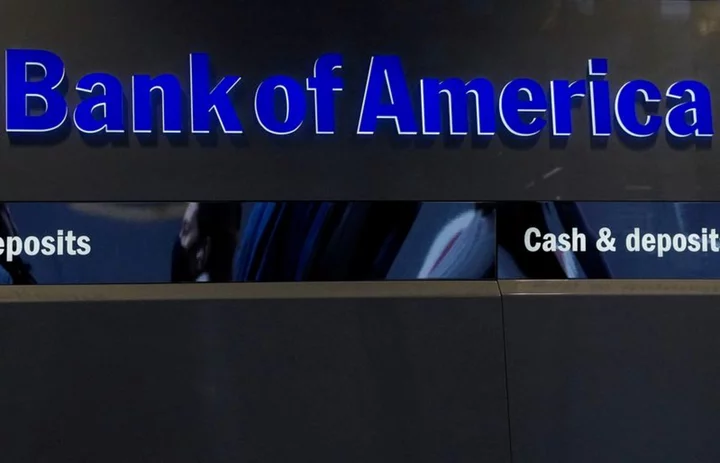By Saeed Azhar and Ann Saphir
NEW YORK/SAN FRANCISCO U.S. lenders are holding onto large piles of cash as insurance against a slowing economy, continuing deposit outflows and looming tougher liquidity rules that could particularly impact mid-sized banks.
The buildup is another example of a risk-averse approach from a sector still trying to regain its footing after a string of springtime bank failures, one which could result in restrained lending.
"This is a logical response to a slowing economy and particularly to a scenario, where you're seeing deposit outflows and you need to conserve cash," said David Fanger, senior vice president at Moody's rating agency.
"What happened in March was a big wake-up call."
The collapse of Silicon Valley Bank and Signature Bank in March triggered massive deposit withdrawals and placed renewed focus on lenders' financial health. More recently, the sector was hit by ratings downgrades when S&P last month cut credit ratings and revised its outlook for multiple U.S. banks, following a similar move by Moody's.
Overall U.S. banks' cash assets were $3.26 trillion as of Aug. 23, up 5.4% from the end of 2022. That was well above typical pre-pandemic levels, though down from the weeks immediately following the bank failures in March, Federal Reserve data shows.
Cash assets at small and mid-sized lenders are up 12% compared with the start of the year; at the nation's top 25 banks, cash holdings are up about 2.9%.
Large banks including JPMorgan and Bank of America declined to comment beyond the disclosures, but pointed to their executives' comments about reasons such as the Fed shrinking its balance sheet, falling deposits and higher short-term rates.
The SVB failure triggered a sudden dash for cash at banks, which within two weeks had bulked up cash assets to $3.49 trillion, the highest level since April 2022. That has pulled back since then, but is still almost twice as high as pre-pandemic.
Banks need higher cash levels to meet liabilities as customers withdraw deposits, and to offset risks such as loan losses as the Federal Reserve keeps interest rates high to cool economic growth and inflation.
"A lot of banks are taking steps to reduce risk and strengthen their balance sheets," said Brendan Browne, S&P's senior credit analyst for financial institutions.
Regional banks are shifting more "earning assets," such as those from lending activities, into cash or short-term securities, said Manan Gosalia, an analyst at Morgan Stanley, who covers regional banks. "As banks see further pressure on deposit costs, and as they hold higher levels of liquidity, we expect loan growth will continue to slow as we get to the end of this year," he said.
S&P forecasts 2% loan growth this year, after an almost 9% gain last year.
STRICTER RULES
Mid-sized banks are also worried about upcoming regulations, analysts said.
U.S. regulators have said they will likely impose stricter capital and liquidity requirements on banks with $100 billion or more in assets.
Since March, regulatory focus has heightened, prompting banks to focus on key capabilities in liquidity and asset liability management, bankers and analysts said.
"Regulators are going to have a shorter fuse" for banks that have any gaps in managing their liquidity and the loans held on their books, said Peter Marshall, leader of EY's financial services liquidity advisory group.
The Fed's aggressive tightening since March 2022 put a lot of banks' longer-term securities under water, creating investor anxiety over the health of bank balance sheets.
Since then, banks are taking steps to boost liquidity by reducing investments in securities or selling them at a loss.
S&P estimated the value of these securities for FDIC-insured banks had more than $550 billion of unrealized losses on their available-for-sale and held-to-maturity securities as of June 30.
Bank of America said in a July presentation it sold $93 billion from the available-for-sale segment of the balance sheet in the first two quarters and added the proceeds to cash, which stood at $374 billion at the end of June, its second-quarter earnings data showed.
It further showed cash, which was deployed in money markets, was generating better returns than keeping it in low-yielding securities.
Bigger rival JPMorgan has been selling securities for the past year. It has $420 billion in cash and $990 billion of what it calls high quality liquidity assets and other unencumbered securities, it said.
"The good news is for some of these banks re-investing cash is that we have pretty high short-term rates," said Mac Sykes, portfolio manager at Gabelli Funds.
"It's definitely opportunistic and advantageous to be investing short-term securities."
(Reporting by Saeed Azhar and Ann Saphir; additional reporting by Niket Nishant; editing by Megan Davies, Nick Zieminski and Richard Chang)

